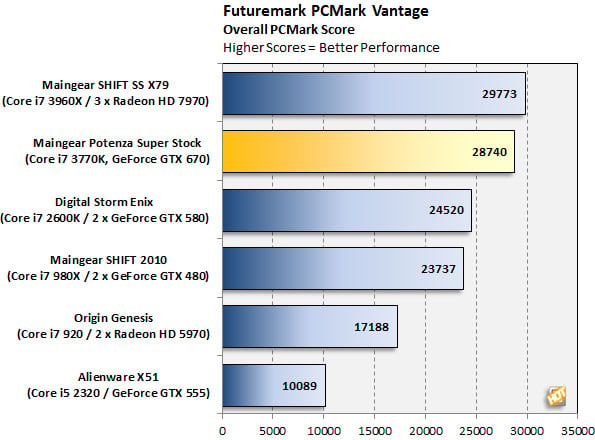Maingear Potenza Super Stock SFF System Review
|
|
|

It's obvious from the benchmark results that PCMark Vantage puts very little emphasis on GPU performance, hence why the single-GPU Potenza is able to hang with the Maingear's three-GPU SHIFT X79 system. Lack of GPU consideration doesn't tell the whole story, however. The Potenza is a well-equipped SFF system with potent parts, particularly the Corsair Force GT solid state drive, which gives the compact rig some all-around muscle. The performance benefits of an SSD, along with an overclocked Ivy Bridge processor, are reflected the PCMark Vantage results.
We see the same situation reflected in Futuremark's updated PCMark 7 benchmark, which again relies heavily on SSD performance. The Potenza only falls a few hundred points behind Maingear's monstrous X79 SHIFT system, which is a credit to how much power the boutique builder was able to cram in such cramped confines. The combination of fast RAM, an overclocked CPU, and SSD + HDD combo results in a system that's well ahead of performance curve and ready to tackle everyday chores with aplomb.
|
|
|
The latest version of Futuremark's synthetic 3D gaming benchmark, 3DMark11, is specifically bound to Windows Vista and 7-based systems because it uses the advanced visual technologies that are only available with DirectX 11, which isn't available on previous versions of Windows. 3DMark11 isn't simply a port of 3DMark Vantage to DirectX 11, though. With this latest version of the benchmark, Futuremark has incorporated four new graphics tests, a physics tests, and a new combined test. We tested the graphics cards here with 3DMark11's Performance preset option, as well as ran the system through a 3DMark Vantage run, which focuses on DirectX 10.

As we switch our focus to 3D performance, we see the Potenza (predictably) fall behind modern multiple GPU systems. Notice, however, how the Potenza creeps past last generation game systems equipped with dual graphics cards. It's also leaps and bounds ahead of Alienware's X51 (not shown in graph) machine, which bench 14,666 in the same test. Both are SFF systems, only the Potenza slaps the Alienware rig around like a little brother.
Cranking things up to the Extreme preset in 3DMark Vantage knocked the score in half, which isn't at all unusual. These are big-time performance metrics despite the Potenza's less-than-big dimensions.

At a glance, 3,371 doesn't seem like much, but it's actually a very good score for a single-GPU machine using 3DMark 11's Extreme preset. To put it into perspective, Dell's XPS One 27 all-in-one (AIO) machine based on Ivy Bridge scored 630 points in this test with a GeForce GT 640M GPU. That's hardly comparable to a GeForce GTX 670, but it underscores how unforgiving the Extreme preset can be.









